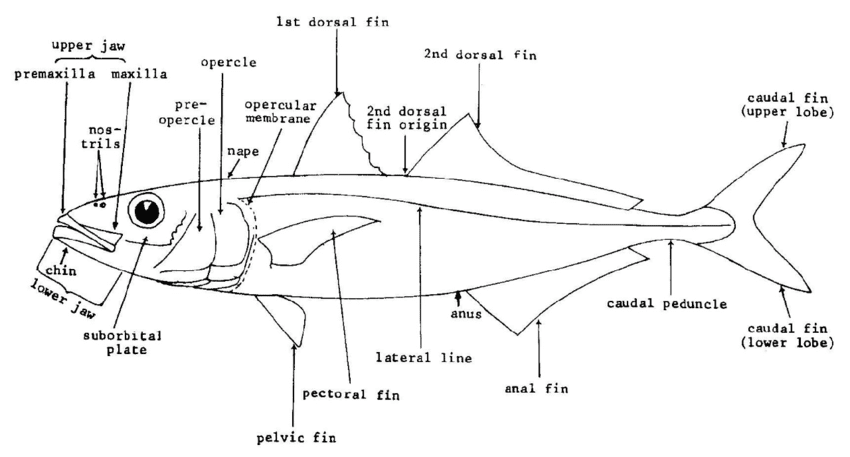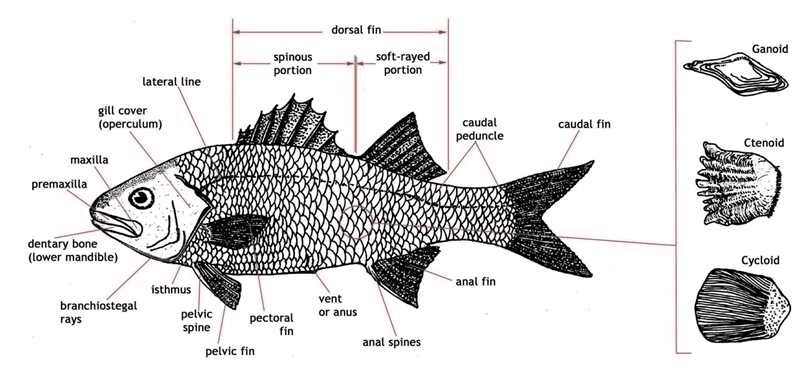The term fish including a bony fish most precisely describes any non-tetrapod craniates which is an animal with a skull and in most cases a backbone that have gills throughout life and whose limbs, if any, are in the shape of fins.
Unlike groupings such as birds and mammals, fish are not a single clade but a paraphyletic collection of taxa, including hagfishes, lampreys, sharks and rays, ray-finned fishes, coelacanths, and lungfishes.
A typical fish is ectothermic, has a streamlined body for rapid swimming, extracts oxygen from water using gills or uses an accessory breathing organ to breathe atmospheric oxygen, has two sets of paired fins, usually one of two (rarely three) dorsal fins, an anal fin, and a tail fin, has jaws, has skin that is usually covered with scales and lays eggs.
Fish display a great variety of forms and are adapted to the environment in which they live in many ways. There are two groups of fish in the class that differs in the composition of their bones. These are; 1. the bony fishes which are fishes with well-developed hard bones like tilapia fishes, and catfish, and 2. the cartilaginous which is a fish with soft flexible fibrous bones called cartilage fish like the shark.
Fish serve as a significant source of food to other living beings. Humans consume a lot of fish. Fish by-products are used in animal rations as a good protein source.
The shape of the body of a fish is well adapted for little resistance in the water. This enables the fish to move quickly through the water. The body of a fish is a spindle which is the oval body that tapers down on both sides shaped with the broader portion in front, and it is flattened on the sides.
Although there are variations on the mentioned shape, the variations serve the individual most of the time to adapt to its immediate surroundings.
Read Also: Basic Guide for Proper Treatment of Fish and Fish Diseases
Body Covering
The body cover of fish assists the animal to travel rapidly through the water. The skin develops scales. Scales reduce the resistance of the fish’s movement through the water. Large numbers of mucous glands occur in the skin of fish.
These glands secrete mucus, which makes the body smooth and allows easy movement through the water medium. Even the gill slits which is the openings of the gills assist with the movement of the fish through water.
Body Divisions of Bony Fish

There are a lot of variations in the shape and size of fish. Even with these variations in mind, the body of a fish can be divided into a head, trunk, and tail. No definite division can be seen between these parts. The head extends to the external gill slits; the tail begins just behind the external cloacae opening.
1. The Head
The external parts of the head are the following:
1. The Mouth: The mouth is situated on the front part of the head. Two movable lips can close the mouth.
2. The Eyes: There are two eyes without eyelids, one on each side of the head. Each eye is covered and protected by a thin transparent epidermis which is the thin transparent skin.
3. The Nostrils: Usually, there are two external openings of the nose above the mouth. The nostrils are used for smelling. The sense of smell is well-developed.
4. The Gills: Between the head and trunk are two bony gill covers, one on each side. They cover the gills and protect them. The gills are the respiratory organs of the fish.
5. The Trunk: The largest part of the body is the trunk and the following anatomical features can be distinguished.
6. The Cloacae: Both the digestive tract and the ureters (the ducts from the “kidneys”) of the fish end in the cavity of the cloacae (external opening of the digestive and urinary tract). The opening is situated at the rear end on the underside of the trunk.
7. The Lateral Line: The lateral (on the side) line extends on either side of the trunk of the fish. The lateral line serves as a gauge for the fish to orientate the fish according to its depth in the water.
Read Also: Introduction to Fisheries Ecology
8. The Fins: The fins of a fish represent the limbs of other vertebrate animals. There are two types namely, paired and unpaired fins. The fins serve as locomotors (help the fish to swim) organs.
8a. The Paired Fins: There are two pairs of paired fins:
i. The Pectoral Fins: They are found towards the lower surface of the trunk. Their positions vary in different species but is usually situated below the pectoral fins. The function of the paired fins is to balance the fish. They also allow the fish to steer slowly through the water.
ii. The Dorsal Fin: There is also an unpaired fin found on the trunk of the fish namely the dorsal fin.
iii. The Anal Fin: The other unpaired fin is called the anal fin and occurs below the lateral line on the lower surface of the trunk
9. The Tail: The trunk narrows gradually and then widens out again into an unpaired fin that forms the tail. This enlarged tail with a big surface plays an important part in the forward and other movements of the fish.
Respiration

Fish breathe by means of their gills. The gills are situated on each side of the head. Four vascular gills which is rich in blood vessels where the blood exchanges oxygen and carbon dioxide, are found in each gill chamber on each side of the head.
Water passes through the open mouth to the gill chambers and surrounds the gills. Gas which contains oxygen and carbon dioxide exchanges between the water and the blood-filled capillaries (small blood vessels) within the gills. The water leaves the gill chambers through the gill slits covered by the gill covers on each side of the head
Reproduction
Fish are unisexual which means that they are both male and female fish exist). The female lays eggs in the water and the male releases sperm into the water over the eggs. Fertilization occurs externally, that is: outside the body of the female. The sun heats the water and the young fish emerge from the eggs on their own.
In summary, the external anatomy of a bony fish includes a head (mouth, eyes, nostrils, and gills), trunk, cloacae, lateral line, fins, and tail, each with a specific function. The Head, trunk, and tail are the major body divisions of a fish; each is characterized by a number of appendages.
Read Also: Household Hazardous Waste (HHW)
